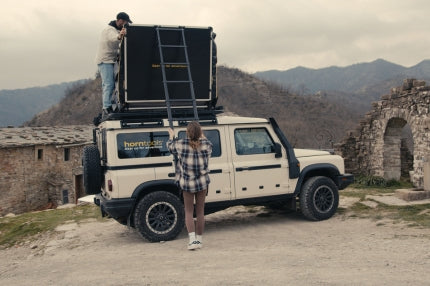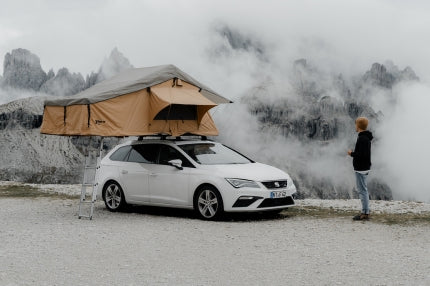If you are thinking about buying a roof tent, you will quickly come across two important terms: dynamic roof load and static roof load. But what exactly do these values mean and how do they affect the installation of your roof tent? In this article, we explain the differences and what you need to pay attention to.
Dynamic roof load - the load during the journey
The dynamic roof load indicates how much weight your car can carry on the roof while driving. This value is crucial, as a high weight on the roof can affect driving stability. The dynamic roof load is specified by the car manufacturer and can usually be found in the owner's manual or the technical data of your vehicle. It includes not only the roof tent itself, but also the roof racks. Typical values for the dynamic roof load are between 50 and 100 kgdepending on the vehicle model.
Static roof load - the load when stationary
The static roof load describes the maximum weight that the vehicle roof can carry when stationary. This value is significantly higher than the dynamic roof load, as the vehicle is not in motion and the weight is distributed evenly. In most cases, a car can carry a static roof load of static roof load of 200 to 400 kg or more when stationarywithout any problems - i.e. the roof tent plus several people.
What does this mean for the installation of a roof tent?
When buying a roof tent, the dynamic roof load is the decisive factor, as your car can only carry a certain weight on the roof while driving. A lightweight roof tent with matching roof racks ensures that you stay within this limit.
The static roof load on the other hand, gives you the assurance that your car can easily carry the additional weight of people in the roof tent when stationary. This means you don't have to worry if you're sleeping on the roof with several people.
Which roof racks do you need?
To mount a roof tent safely, you need suitable roof racks or a platformthat can support the weight of the tent. These must also match the dynamic roof load of your car. horntools offers a variety of roof rack platforms that are ideal for mounting your roof tent. We attach great importance to the lowest possible weight with the largest possible surface area.
Conclusion
-
Dynamic roof load = Weight limit while driving (e.g. 75 kg)
-
Static roof load = load when stationary (often 200 kg or more)
-
Choose a roof tent and roof rack that match the dynamic roof load of your vehicle.
-
Don't worry: the static roof load is almost always sufficient to sleep safely in the tent.
With this knowledge, you can now make sure that your car is suitable for a roof tent and you can start your next adventure well prepared!



Leave a comment
All comments are moderated before being published.
This site is protected by hCaptcha and the hCaptcha Privacy Policy and Terms of Service apply.